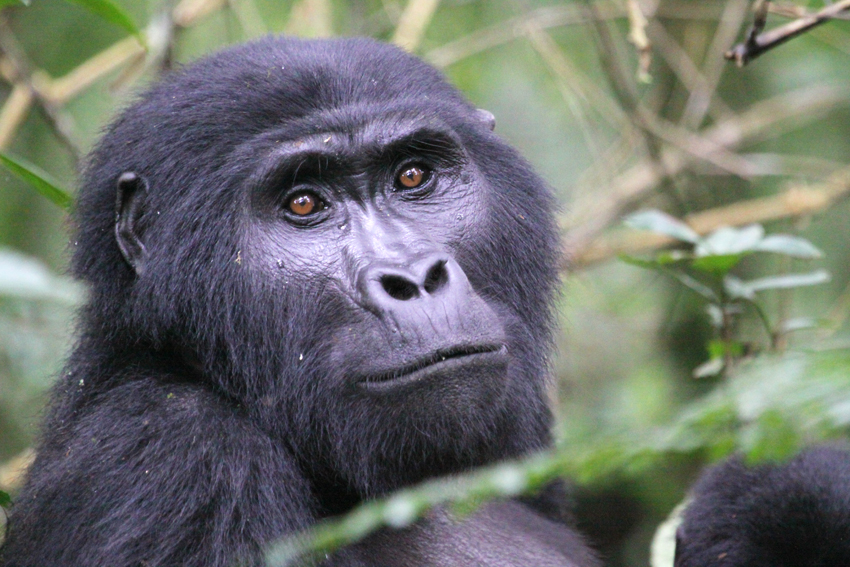Visiting Unhabituated Mountain Gorillas In The Wilderness.
Whether your trip is gorilla trekking, Gorilla habituation, or gorilla census in the wild, seeing unhabituated or semi-habituated gorilla families in the wilderness might be challenging.
Mountain gorillas roam freely in the Bwindi Impenetrable National park and Mgahinga National park in Uganda. Mountains gorillas call Volcanoes National Park home in Rwanda. Mountains gorillas call Virunga National Park in D.R. Congo home. The mountain gorillas are only found in the Virunga region, which consists just of the following nations worldwide.
Historically, people used to greatly interfere with the existence of the wild mountain gorillas and had no relationship with them. The mountain gorillas sometimes would also invade human gardens and consume the crops there. Many mountain gorillas were slain, others abducted for entertainment, still others kept as pets, and yet more.
According to Dian Fossey, all these crimes cause the great decline in the global mountain gorilla count to about 300 by 1980s.
Allowing people to see the mountain gorillas—today known as gorilla habituation—was one way to close the distance between humans and the mountain gorillas. Getting mountain gorillas used to seeing people without changing their natural way of life.
Both sides realize the need of co-existence more the more tourists approach the wild mountain gorillas.
The mountain gorillas were on the verge of extinction in the 1980s; International Union for Conservation of Nature (IUCN) has declared them as among the most threatened species worldwide.
The populations have begun to rise as noted in every census because to the great conservation effort both domestically and internationally directed toward mountain gorillas.
How to handle unhabituated mountain gorillas?
Together, veterinary specialists, rangers, and researchers assist with the mountain gorilla habitation process. Depending on the degree of wildness the mountain gorillas are at, this procedure may take some amazing length—between three years and five years or more.
Every day, information is gathered and reorganized about the mountain gorillas. Dung is collected and sent to the lab for study; some samples include hairs from past night nests.
Every family member’s unique behavior, birth count of babies, female and male family count are recoded and so much more. Names are given to certain gorilla family members over time to provide simple identification.
To get the dominating silverback’s attention throughout this gorilla habituation process, the participants must demonstrate great respect for him.
Head of the whole gorilla family, he once approved of human presence; thereafter, the others follow, and a gorilla family is ready for gorilla trekking.
Unlike the completely habituated family visited for just one hour, a party of around 4 visitors may be permitted to see and follow the semi-habited gorilla trekking family for approximately 4 hours.
The semi-habited gorilla trekking family is still under study and exhibits wild behavior; so, you should follow the advice of the ranger guides and group researchers. Otherwise, you could change the so far produced by this group in case you encourage or engage in any questionable activity directed towards the mountain gorillas that might raise questions.
You have to bring the correct gorilla habituation tools to get you through the whole forest. You will need a great deal of humility and patience to appreciate seeing these semi wild mountain gorillas. Remember they are the lords of the forest; sometimes, gorilla families with multiple silverbacks assign defensive responsibilities to these powerful males to guard the members against invaders.
The gorilla surveillance network can see and document anything you do in the forest for the dominating silverback. Recall mountain gorillas have DNA around between 96% and human levels.
Their moodiness also fits the general conditions in the forest. You have to attend briefing before going into the bush to go for gorilla habituation or gorilla trekking so that you have a better idea of what you are about to come across.
Methods Dian Fossey Applied To Track Unhabituated Gorilla Groups
One way to establish visual contact with what would out to be the whole family was somewhat unexpected and practically never replicated in the remainder of the census: observing an unhabituated group for forty-two minutes.
Using high powered binoculars, Bill was able to view eight of the people well enough to create their nose prints. Most animals show some individual identity, including variances in zebra stripes or markings on an elephant’s ear.
From their body shape and posture, we could tell the gorillas in groups 4 and 5 only once. But we relied on the distinct patterns of deep lines creasing the skin above their nose to distinguish unhabituated and less well-known gorillas. Karisoke preserved sketches of these nose prints to track people who weren’t part of long-term research teams.
When we got back to camp some days later, we could clearly identify four of the prints with those of three females and an adolescent from their prior group.
While seeing gorillas is interesting and personally fulfilling, the core of census work is the nest count. Rwelekana and Bill therefore turned away from the gorillas and ascended back out of the canyon to search for the morning path with fewer than three hours of light remained.
Finding it less than a hundred meters up the ridge, we reversed South West over a wide grassy slope and into the kujiua gorge. We arrived on the far rim of the nest location of the night before little over an hour later.
Although twelve nests were counted, none had young dung, which is concerning for a group with seven adult members most likely having four to five breeding age females.
Bill and Rwelekana got their bags and settled into the evening’s lodging after a quick trip back to the Grand Canyon. Presumably six feet deep and no more than twenty feet long, the cave turned out to be more of a recessed ledge in the canyon side.
The only indication of a leopard was some very old scat in one corner; yet, the solitary steep entrance to one side and the sheer drop down before us begged fascinating ideas about a potential return of the chui, as the leopard is called in Swahil.After eating a pot of rice and beans, however, we laid our sleeping bags on the Rockledge and sank fast into a deep slumber.
The piercing cries that next tore through the evening silence were of a sort and strength Bill had never dreamed imaginable. Turning on a headlamp after assessing his position and the few means of escape, he saw Rwelekana, too, waking.
The cries came again, rising to an appalling pitch. Some wretched creature being torn to bits and devoured alive, sinew by sinew, someplace in the dark and cruel world beyond our cave was easily imagined.
The murderer turned out to be the leopard. Would it pull the leftovers back here? Rwelekana grinned and muttered ikoimperere as she saw Bills expanding eyes. Though he understood the Kinyarwanda phrase for the tree hyrax, Bill couldn’t believe the shrieks could come from an animal the size and look of a hedgehog. The hyrax is the closer living cousin of the elephant, according to some biologists.
Others say its banshee-like vocalizations indicate the territory of the hyrax and its mating readiness. Before bill could fit any of these facts with his own impressions, he slept off.
Though less exciting, the following several days were nevertheless busy. Extra nest counts verified the twelve total number of animals in the first group—no newborns.
On the mountain’s North East slopes, we came across two additional families with six and eight members. We demolished a patch of marijuana next to another poacher cave and removed an active poacher cabin on the aptly called fury Hill.
We sadly ran out of food and had to refill before we could consume all of Mt. Visoke. We headed straight back to Karisoke in order to save time—if not effort.
This entailed navigating a series of ravines halfway up the mountain before we came onto one of the paths of research access. We were face-to-face with a screaming ground-slapping silver back after crossing a very fresh gorilla path that we had to pursue in case it revealed another unidentified group minutes.
Brutus appeared the most plausible choice given the style and the environment—another tight tunnel of plants. As he performed his ambush behavior four more times as we attempted to descend the slope into camp path, we verified this identity.
We split ways; Rwelekana walked down to his house down the mountain, while Bill ascended the last half-hour to camp. From far above, brutus kept airing his annoyance.
Another interesting choice by Dian delayed Bill’s intended return to complete the Visoke survey. She was pretty eager to hear about Bill’s discoveries and first felt hopeful that Visoke might have more gorillas. Not to find younger was frustrating, but generally the stats were decent.
Bill was so surprised to get a message from Dian the next day declaring that she would no longer be able to pay for the expenses of the census project.
Expense was an unlikely reason at a limit of $10 a day for two Rwandans and all the beans they could eat. She was more likely worried that the slightly optimistic figures would contradict her public claims that the population of mountain gorillas had been declining and was now less than two hundred. She wanted neither evidence nor argument; it was a dismal outlook that more and more suited her mood.
What Should He Bring to See the Mountain Gorillas?
Safari Monitoring Boots
The thick river network and consistent rain make the jungle harsh and wet; so, you should choose shoes that will shield your feet from such environment.
Long slung shirts and long pants
Wearing clothing covering the most of your body can help you defend yourself from stinging insects, sharp surfaces and so much more. Packing safari convertible pants reduces the total clothing you carry.
Safari folding cap
Your head has to be protected from flying insects and water dripping from the leaves.
Medicated bug repellent
Applying an insect repellent helps you to avoid damage to your body from jungle stinging insects.
Two stocks:
You need stockings to tack in your pants and protect your body from stealthy insects that could find their way in.
Ponché or raincoat
This region gets late rainfall, hence you have to be ready in case
A pair of binoculars
You’ll need binoculars if you want to clearly see far-ranging sights.
Gloves for gardens
While going in the bush, you may inevitably find yourself clinging to creepers or falling done; yet, you must guard your hands.
Some hotels may not provide such conveniences, so you should carry your own toiletries.
Energy Dipsitsions
It is unknown when one returns for another meal after gorilla treking after breakfast. You ought to carry some energizers you might eat on your way to see the mountain gorillas.
a waterproof bag
Every item you own should be packed in one bag to prevent them from becoming wet or dispersed should it rain.


